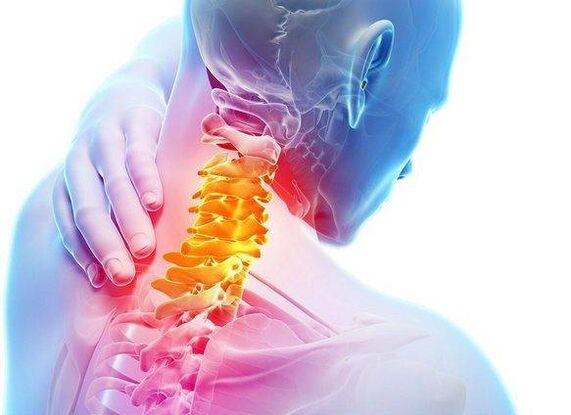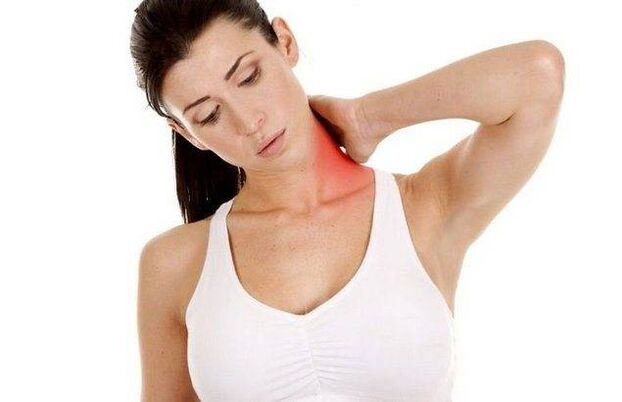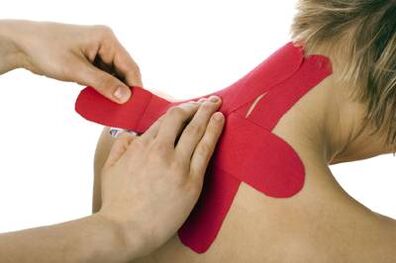A sedentary lifestyle characteristic of employees and those who love to relax in front of the TV or behind the monitor screen often cause osteochondosis. In the article we will consider what is the osteochondosis of the cervical column, the main causes of this disease, its symptoms and phases, the methods of treatment, as well as answer other questions that occur in patients with osteochondrosis.

The osteochondro process simultaneously affects any of the spine. The lumbar and cervical vertebrae are more affected by pathologies, like the most susceptible to loads due to the anatomy of the human skeleton. The consequences of the osteochondosis spinal in the cervical region cause the greatest inconvenience and potential complications, because the neck is an area rich in neuromusive highways, many of which directly feed the brain. In addition, the nerve roots, which provide the sensitivity and motor activity of the hands and the shoulder belt, when squeezing with destroyed vertebrates can give a variety of symptomatic paintings.
The signs of osteochondosis of the neck depend on which of the body systems are influenced by the pathology:
- Blood circulation interrupted due to the pressure of the vertebral arteries determines most of the complexes of the symptoms from the brain.
- The compression of the roots that leave the vertebrates gives an image of the injury of the peripheral nerves.
- The pinch of areas of the spinal cord is associated with serious neurological pathologies found in advanced cases.
Below, consider the general clinic of the osteochondrosis of the cervical column. Pain in the back of the head, neck and collar. This is the most common symptom. The location of the pain can be expanded, by hitting the shoulders, the region of the clavicle, the chest, the transformation into intense head heepsters. The nature of pain depends on the location of the injury and the severity of the pathology. Initially, pain can be quickly transient, gradually becoming chronic, painful. In times of exacerbations, the pain becomes shot, in an increased tone of the muscles of the neck and a limited movement of the head. Often, pain with cervical osteochondrosis can be located behind the sternum, in which case many patients take this symptom for Angina Pectoris.
Noise, ring, feeling of congestion in the ears
These symptoms often join a decrease in hearing. These phenomena are associated with a decrease in blood flow from vertebral arteries to the vestibular apparatus. The complex of these symptoms is called coclear syndrome or snail and is far from always determining its connection with osteochondrosis in the cervical region. A specific feature for differentiation is that noise, congestion and ringtone in ears feel when changing the location, after a long stay in a position.
Dizziness
The dizziness are also due to the violation of the blood flow to the organs of the internal ear, which guarantees the balance of the body. Nystagm often combines vertigo - arbitrary fluctuations in the pupils of the eyes on the sides.
Missing aerial
This sensation appears due to the irritation of the ends of the diaphragmatic nerve. It is a component of the cervical nerve ray and is involved in the adjustment of breathing, in its depth and frequency. Patients complain of the inability to breathe in the fullest chest. In some cases, the symptom worsens a serious lack of breath and suffocation. For the same reason, breathing stops at night and snoring. The disadvantage of oxygen due to breathing problems is ultimately the cause of the increase in fatigue, a decrease in concentration and memory problems.
Nausea
It is accompanied by the healing air. Also due to problems with blood circulation in some areas of the brain and internal ear. The nausea is sometimes observed with an indomitable vomiting caused by the movements of the head and the body. The consequence of frequent nausea and vomiting is a decrease in appetite, weight loss, food failure.
Problems with vision

"Flies" in the eyes, a decrease in visual acuity, fog in front of the eyes: these are all the symptoms due to the ischemia of the brain area which is responsible for vision. Patients with osteochondrosis complain less commonly from vision, since the lack of blood supply from vertebral vessels is compensated by the blood flow by the carbon arteries system. Glasses and therapeutic gymnastics for the eye muscles do not solve the problem, usually the vision improves after the treatment of osteochdrosis.
Green symptoms
It can often be the only sign indicating cervical osteochondosis. They are expressed as a sweat, dryness and feeling of a lump in the throat, difficulty with swallowing. The symptoms are associated with the compression of the nervous plexus responsible for the caking of the pharynx. It is necessary to differentiate these manifestations from a similar clinic in inflammation or neoplasms.
How to treat cervical osteochondosis
The described state of the spine is a very serious pathology, which, with abandonment, leads to disability and following deep disorders of brain circulation and death. For this reason, for cars -marization, if these symptoms appear, you shouldn't do it. Osteocondrosis is treated in a hospital and home, exclusively as prescribed by a doctor. In the initial phases, the treatment of cervical osteochdrosis is conservative, which includes prescriptions of drugs: non -steering antimammator drugs, anesthetics, hormonal drugs, vitamin complexes, chondroprotectors -all this relieves the influence, pain, improves the trophic and vertebrae cartilage.
In the acute period, the drugs are prescribed in the form of injections, since pain attenuates, the patient goes to the tablets. Physiotherapy, massage, exercises of exercises, usually prescribed in the remission phase, join the drug courses. In difficult cases, osteochondrosis is treated with surgery.
The diagram of the cervical column
The osteochondrosis of the cervical column (Osteohondroz) is a degenerative dyeing dyeing of the intervertebral discs, which damage the wheels, vertebrae and joints of the cervical region, a decrease in the height of the intervertebral discs is observed. The disease progresses if it is not treated and can lead to headaches, circulatory disorders and even hernias. Like osteoporosis, the disease occurs due to a violation of the mineral metabolism, due to which the bones and joints become less durable. Osteocondrosis can cause the cervical column instability (the symptoms and treatment are similar to the chondro, but have a series of characteristics), which is often accompanied by a movement of the vertebrae. In turn, this accelerates the development of the osteocondrosis, destroying the vertebrato.
The main causes that can cause osteochondrosis:
- improper nutrition and excess weight;
- Posture violations, scoliosis, rheumatism, flat feet;
- Sedentary lifestyle: sedentary work (drivers, employees), lack of physical effort, etc. ;
- neck lesions, spinal lesions;
- Too much physical activity, unusual for the body;
- nervous tension, frequent stress;
- hereditary predisposition to the development of the disease;
- Wrong development of the cervical column.

Most of the above reasons cause a load on the cervical vertebrae, due to which muscle spasm occurs. For this reason, the blood circulation process is disturbed, the effectiveness of metabolic processes is reduced, which causes degenerative changes. The structure of the intervertebral discs changes, are diluted and deformed, speaking beyond the spine. Often the cause of the osteochdrosis is a progressive disk, widespread in the vertebrae or the adjacent bone tissue. It occurs more often with prolonged physical effort in the lumbar and cervical, almost never touching the chest. Development, osteochondrosis crosses several phases characterized by some signs and symptoms. We will consider these phases below.
Osteochondrosis of the 1st degree of the cervical region (preclinical stage)
Usually, in the initial phase of the development of the disease, only a slight sanding of the necky of the neck is observed, patients experience the intense of pain with the curves and the inclination of the head, the tension and the rapid fatigue of the muscles in the back and in the lower back of the back. At this stage, osteochondosis is treated without medicines, it is sufficient to change nutrition, perform exercises and other events.
Osteochondrosis 2 degrees
In the second stage between the vertebrae, instability is observed, the patient begins to disturb a more intense pain, which periodically gives him his hands or shoulders, the pain is also intensified with curves and tilting of the head. Patients begin to notice rapid fatigue, absent mentality, reduction of the performance level and headache.
Osteochondrosis 3 degrees
At this stage, the pain begins to intensify, it occurs constantly not only in the neck, but also in the back, it gives it to its hands. The muscles of the hand become weaker, numbness is observed, since the hernias of the intervertebral records begin to form. In this case, the diagnosis reveals the small mobility of the cervical region. Patients are worried about dizziness and weakness.
Osteochondrosis 4 degrees
In the final phase, the intervertebral discs are destroyed, which are replaced by the connective tissue. The pathological process simultaneously affects several segments of the ridge, which can be in different phases of destruction. In patients there is a violation of coordination, dizziness and pain have improved, there is noise in the ears and other ailments. The initial phase of the disease can also be identified according to the following signs:
- Headache for osteochondosis of the cervical region
- neck pain, on the neck, behind or to the arms;
- weakness of the hands;
- crunch and pain during the movements of the head;
- General weakness, fatigue, compromised coordination, dizziness;
- Reduce the acuteness of vision and hearing, numbness of the language.

One of the most common signs is the dizziness for the osteochondosis of the cervical column. At the same time, the symptoms of dizziness can be accompanied by noise and the ring in the ears (reduced hearing acuity), the sensations of disorientation, migraine, as well as nausea and vomiting. In addition, it is the doctor who determines how to treat these symptoms that should not be made to get rid of dizziness with popular methods. Another unpleasant consequence is frequent headache, especially in women. Migraine can occur several times a day, causing unpleasant and painful sensations. The signs of the disease of the cervical region manifest themselves slightly different from the osteocondrosis of the other spine in relation that the vertebrae in the neck are close to each other, the height of the intervertebral discs is small, which leads to complications even with small degenerative changes.
Symptoms of cervical osteochondosis that occur in the brain
With the development of osteochondrosis, the blood flow towards the cerebral crosses the arteries, which are compressed by the protruding edges of the vertebrae, decreases. As a result, there is a violation of the blood circulation of the brain. In patients, neurotic disorders are observed: irritability, anxiety, frequent change in mood, resentment, insomnia, the ability to concentrate is reduced. In some cases bursts of anger, fear, desire may occur. Vascular spasms can lead to fainting, headache, noise in the ears, the appearance of the points in front of the eyes. In this case, the following symptoms of exacerbation appear: dizziness, feeling of instability, nausea, in some cases vomiting.
Treatment of the osteocondrosis of the cervical column
For the treatment of a disease such as osteochondrosis, various methods are used: medicines, physiotherapy, massage of the cervical-coatral area for the flow of blood to the brain and therapeutic gymnastics and maintaining proper nutrition. Despite the fact that women are more susceptible to the headache and numbness of the limbs in this disease, the treatment of cervical osteochondrosis in women is no different from its treatment in men: the same drugs and exercises are prescribed.
Diagnostic methods
An expert doctor diagnostic the cervical osteochondrosis easily, since the disease has a characteristic clinical picture. To determine the stadium, abandonment and prevalence of the pathological process, an additional number of exams are prescribed:
- X -ray: a change in the mobility and arrangement of the vertebrae, a decrease in intervertebral cracks, saline deposits are determined;
- Computerized tomography: allows you to see empty spaces, changes in the height of the disc, instability of the vertebrae, compression of the nerve fibers and the spinal cord;
- Magnetic resonance imaging allows you to carefully see pathological changes, determine the blood flow and the condition of the nerve roots.
Usually, only the radiography of the cervical column is sufficient, more expensive methods are used in confused and unclear cases.

Medical physical education
The exercises for the cervical osteochondrosis can strictly do during remission, the movements in the acute phase can lead to a deterioration of the patient's conditions. All physiotherapy exercises are reduced to the curves and inclinations of the head. It is important to perform actions slowly, without sudden movements. In case of pain, stop the lesson and ask for advice on a specialist.
If a person has a tendency to develop pathology, he must periodically visit a specialist and undergo research. This will help to identify the disease in an initial phase and start treatment in time. For example, cervical osteochondrosis, whose symptoms are described in the article, affect the cervical vertebrae and begin to literally destroy them. What will come, is easy to guess.



















